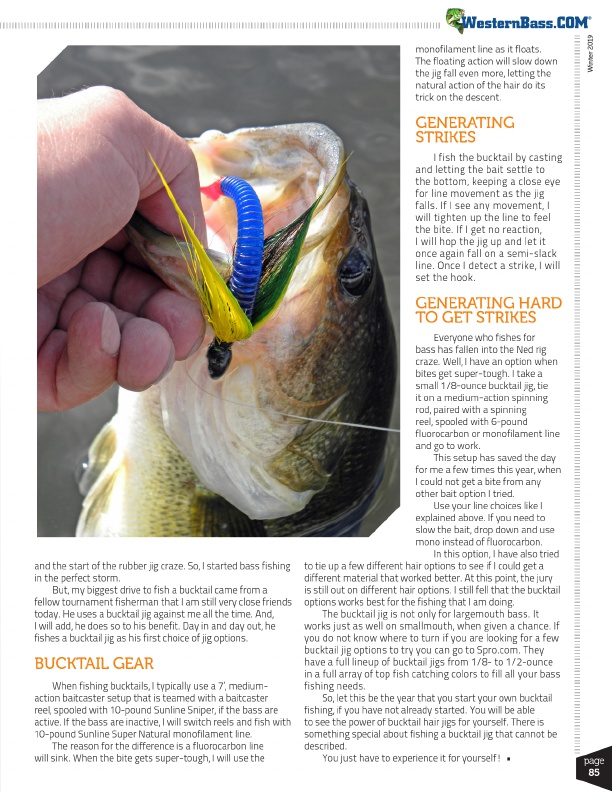
®
monofilament line as it floats. The floating action will slow down the jig fall even more, letting the natural action of the hair do its trick on the descent.
GENERATING STRIKES
I fish the bucktail by casting and letting the bait settle to the bottom, keeping a close eye for line movement as the jig falls. If I see any movement, I will tighten up the line to feel the bite. If I get no reaction, I will hop the jig up and let it once again fall on a semi-slack line. Once I detect a strike, I will set the hook.
and the start of the rubber jig craze. So, I started bass fishing in the perfect storm.
But, my biggest drive to fish a bucktail came from a fellow tournament fisherman that I am still very close friends today. He uses a bucktail jig against me all the time. And, I will add, he does so to his benefit. Day in and day out, he fishes a bucktail jig as his first choice of jig options.
BUCKTAIL GEAR
When fishing bucktails, I typically use a 7’, medium- action baitcaster setup that is teamed with a baitcaster reel, spooled with 10-pound Sunline Sniper, if the bass are active. If the bass are inactive, I will switch reels and fish with 10-pound Sunline Super Natural monofilament line.
The reason for the difference is a fluorocarbon line will sink. When the bite gets super-tough, I will use the
GENERATING HARD TO GET STRIKES
Everyone who fishes for
bass has fallen into the Ned rig
craze. Well, I have an option when
bites get super-tough. I take a
small 1/8-ounce bucktail jig, tie
it on a medium-action spinning
rod, paired with a spinning
reel, spooled with 6-pound
fluorocarbon or monofilament line
and go to work.
This setup has saved the day
for me a few times this year, when
I could not get a bite from any
other bait option I tried.
Use your line choices like I
explained above. If you need to
slow the bait, drop down and use
mono instead of fluorocarbon.
In this option, I have also tried to tie up a few different hair options to see if I could get a different material that worked better. At this point, the jury is still out on different hair options. I still fell that the bucktail options works best for the fishing that I am doing.
The bucktail jig is not only for largemouth bass. It works just as well on smallmouth, when given a chance. If you do not know where to turn if you are looking for a few bucktail jig options to try you can go to Spro.com. They have a full lineup of bucktail jigs from 1/8- to 1/2-ounce in a full array of top fish catching colors to fill all your bass fishing needs.
So, let this be the year that you start your own bucktail fishing, if you have not already started. You will be able to see the power of bucktail hair jigs for yourself. There is something special about fishing a bucktail jig that cannot be described.
You just have to experience it for yourself! •
Winter 2019
page 85